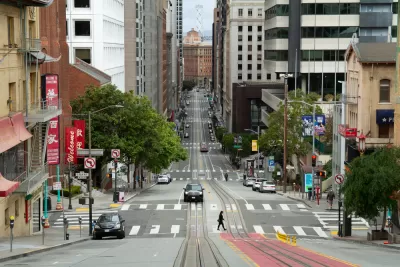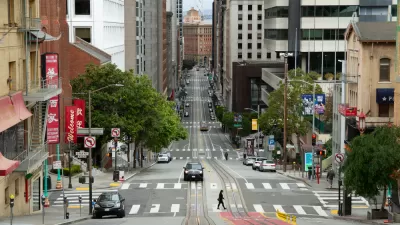The recovery of U.S. downtowns is happening at widely different paces depending on which city you consider.

A recent analysis by the Institute of Governmental Studies at the University of California, Berkeley compares the recovery of downtowns using new data provided by mobile phones to expand beyond the typical indicators of downtown vitality: office vacancy rates, public transit ridership, and retail spending.
The study finds wide variation in downtown recoveries, ranging from a low of 31 percent of pre-pandemic levels in San Francisco to a high of 155 percent in Salt Lake City. The key factors influencing these outcomes, according to the study, are “population and business densities, commuter mode shares particularly high car use, along with presence of industry sectors that are continuing to support remote work (such as tech and finance),” according to the policy brief that supplements an infographic-oriented website to share the information released with the study.
The release of the study has inspired some local media coverage, including an article by Mike Rogoway for the Oregonian examining Portland, Oregon’s “sluggish” recovery (only San Francisco and Cleveland fared worse, according to the study). An article by Snejana Farberov for the New York Post was quick to point out how many cities are doing worse than New York recovering from the pandemic. An article by Roland Li for the San Francisco Chronicle recently made a similar point without citing the Berkeley study.
For more research into the uneven recovery from the pandemic, see also research published by the Brookings Institution in June 2022, which also identifies winners and losers among metropolitan areas in the new, post-pandemic normal.
FULL STORY: Death of Downtown?

Planetizen Federal Action Tracker
A weekly monitor of how Trump’s orders and actions are impacting planners and planning in America.

Maui's Vacation Rental Debate Turns Ugly
Verbal attacks, misinformation campaigns and fistfights plague a high-stakes debate to convert thousands of vacation rentals into long-term housing.

San Francisco Suspends Traffic Calming Amidst Record Deaths
Citing “a challenging fiscal landscape,” the city will cease the program on the heels of 42 traffic deaths, including 24 pedestrians.

Defunct Pittsburgh Power Plant to Become Residential Tower
A decommissioned steam heat plant will be redeveloped into almost 100 affordable housing units.

Trump Prompts Restructuring of Transportation Research Board in “Unprecedented Overreach”
The TRB has eliminated more than half of its committees including those focused on climate, equity, and cities.

Amtrak Rolls Out New Orleans to Alabama “Mardi Gras” Train
The new service will operate morning and evening departures between Mobile and New Orleans.
Urban Design for Planners 1: Software Tools
This six-course series explores essential urban design concepts using open source software and equips planners with the tools they need to participate fully in the urban design process.
Planning for Universal Design
Learn the tools for implementing Universal Design in planning regulations.
Heyer Gruel & Associates PA
JM Goldson LLC
Custer County Colorado
City of Camden Redevelopment Agency
City of Astoria
Transportation Research & Education Center (TREC) at Portland State University
Jefferson Parish Government
Camden Redevelopment Agency
City of Claremont





























